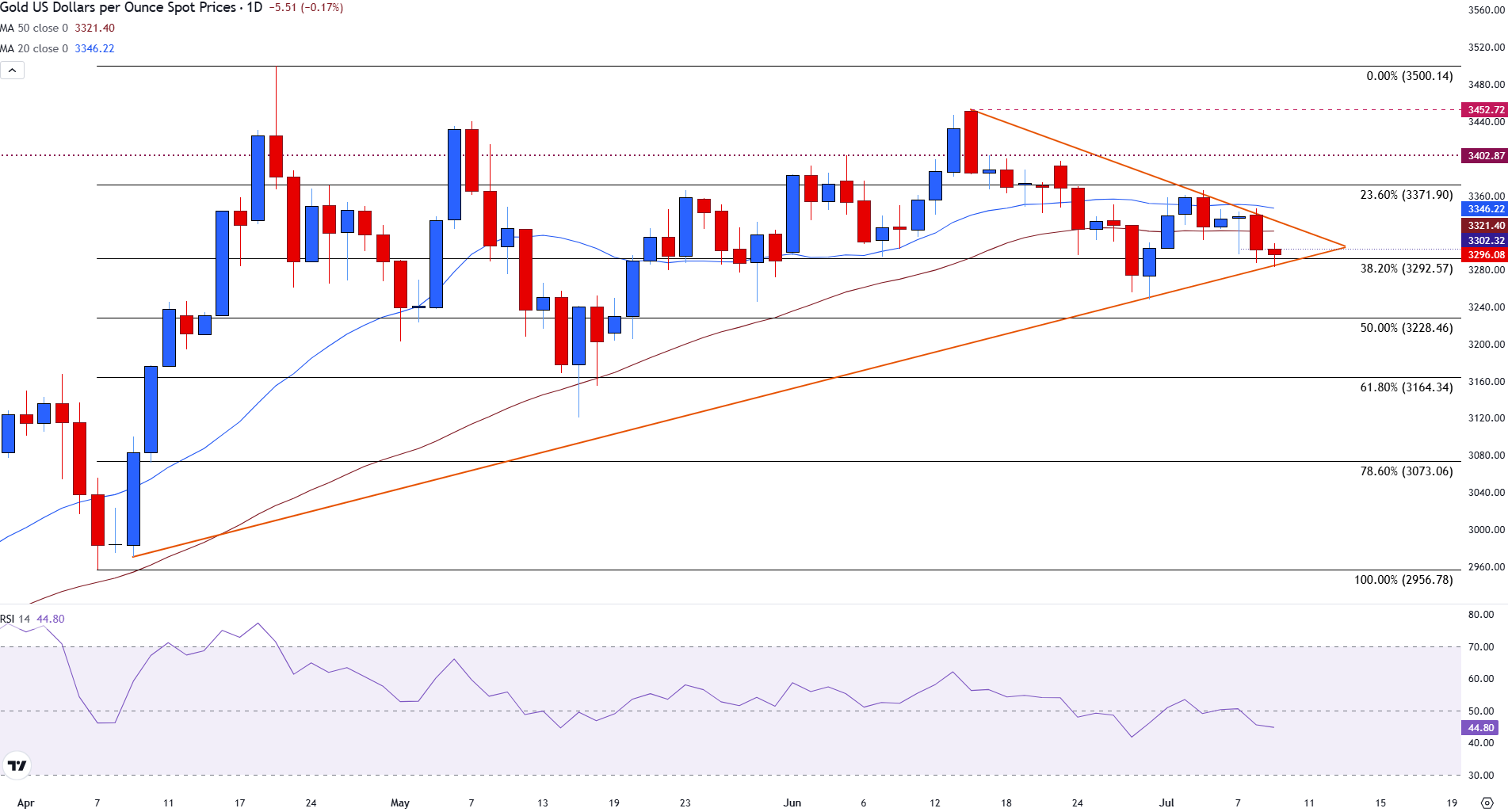- Gold price rebounds as the US Dollar Index falls from its two-week highs.
- Fed Minutes remain in focus as investors search for clues of whether the Fed is considering a near-term rate cut.
- XAU/USD attempts a recovery as the yellow metal rebounds from symmetrical triangle support.
Gold (XAU/USD) is extending its decline on Wednesday for a second consecutive day as the US Dollar (USD) and US Treasury yields firm ahead of the release of the Federal Open Market Committee (FOMC) Meeting Minutes.
The US Dollar Index (DXY) is falling after testing its highest level in two weeks, pushing XAU/USD above $3,300 at the time of writing.
The upcoming release of the FOMC Minutes from the June meeting is expected to shed light on the Fed’s internal debate over the path of monetary policy.
In June, the central bank opted to maintain its benchmark interest rate at 4.25% to 4.50%, citing a resilient labor market and lingering inflation pressures.
Last week’s Nonfarm Payrolls (NFP) report reinforced that outlook, showing continued strength in employment and reducing expectations for a near-term rate cut. As a result, yields have firmed across the curve, further strengthening the USD and weighing on Gold.
Gold typically shares an inverse relationship with the US Dollar and interest rates. When yields rise, interest-bearing assets become more attractive relative to Gold, which does not offer a yield. This dynamic has continued to pressure bullion in recent sessions.
Trade prospects and tariff extension dampen Gold’s short-term appeal
Letters outlining the reciprocal tariff rates that the Trump administration aims to impose on imports to the US continue to be sent to trading partners of the World’s largest economy.
This has reignited concerns over the potential economic implications of the levy increase.
The latest news that the European Union (EU) and the United States (US) are making progress in trade talks has provided additional support for the Greenback.
However, with the new rates expected to take effect from August, the three-week extension has increased the hopes that more trade deals between the US and its major counterparts could be announced. This has weakened the short-term appeal of bullion.
Daily digest market movers: Gold hinges on Fed outlook and trade policy
- According to the CME FedWatch Tool, markets are pricing in a 62.9% probability for a 25-basis-point rate cut in September. So far this year, the Fed has maintained interest rates within the 4.25%-4.50% range, supported by a resilient labour market.
- Meanwhile, President Trump continues to criticize Fed Chair Jerome Powell. On Tuesday, Trump called for his “Immediate resignation”. On Truth Social, Trump stated, “Rates should have been cut months ago. The only reason they’re not is because Powell doesn’t want me to win.” These remarks reflect Trump’s long-standing frustration with Powell, which began during his first term and has intensified as monetary policy remains tight.
- On tariffs, the Trump Administration has hinted at imposing a 50% tariff rate on Copper imports to the US and a potential 200% levy on pharmaceutical products.
- At a Cabinet Meeting on Tuesday, Trump reiterated that there would be no further extension to the fresh tariff deadline on August 1. “Everybody has to pay. And the incentive is that they have the right to deal in the United States. ”Trump wrote on Truth Social that “TARIFFS WILL START BEING PAID ON AUGUST 1, 2025. There has been no change to this date, and there will be no change.”
- On Monday, 14 letters were sent to countries, including Japan and South Korea, outlining the fresh tariff rate. On Tuesday, US Commerce Secretary Howard Lutnick told CNBC that an additional 15 -20 letters were scheduled to be sent to global leaders by Wednesday.
- Trump also threatened BRICS with an additional 10 % tariff. BRICS nations collaborate on various issues, including trade, investment, finance, and sustainable development. They aim to increase their influence in global economic and political affairs. The bloc also holds annual summits to discuss and coordinate strategies for mutual support and growth.
Gold technical analysis: XAU/USD lingers above $3,300
Gold (XAU/USD) is attempting a recovery after reaching a one-week low on Wednesday, which pushed the price to the lower boundary of a symmetrical triangle pattern.
The 38.2% Fibonacci retracement level at $3,292 of the April rally, which has served as a key short-term support level over recent weeks, currently remains intact.
Gold (XAU/USD) daily chart

A sustained move below this level could expose Gold to further losses, targeting the 50% Fibo level at $3,228, followed by $3,164.
On the upside, resistance is aligned at the 50-day Simple Moving Average (SMA) at $3,321 and the 20-day SMA at $3,345.
The 23.6% retracement level is providing an additional barrier of resistance at $3,372, with a move higher opening the door for the $3,400 round number.
The Relative Strength Index (RSI) is holding near 44, reinforcing the emergence of bearish momentum.
The metal’s failure to hold above its moving averages and the triangle apex favour downside continuation, unless bulls can convincingly gain traction above $3,345.
Fed FAQs
Monetary policy in the US is shaped by the Federal Reserve (Fed). The Fed has two mandates: to achieve price stability and foster full employment. Its primary tool to achieve these goals is by adjusting interest rates.
When prices are rising too quickly and inflation is above the Fed’s 2% target, it raises interest rates, increasing borrowing costs throughout the economy. This results in a stronger US Dollar (USD) as it makes the US a more attractive place for international investors to park their money.
When inflation falls below 2% or the Unemployment Rate is too high, the Fed may lower interest rates to encourage borrowing, which weighs on the Greenback.
The Federal Reserve (Fed) holds eight policy meetings a year, where the Federal Open Market Committee (FOMC) assesses economic conditions and makes monetary policy decisions.
The FOMC is attended by twelve Fed officials – the seven members of the Board of Governors, the president of the Federal Reserve Bank of New York, and four of the remaining eleven regional Reserve Bank presidents, who serve one-year terms on a rotating basis.
In extreme situations, the Federal Reserve may resort to a policy named Quantitative Easing (QE). QE is the process by which the Fed substantially increases the flow of credit in a stuck financial system.
It is a non-standard policy measure used during crises or when inflation is extremely low. It was the Fed’s weapon of choice during the Great Financial Crisis in 2008. It involves the Fed printing more Dollars and using them to buy high grade bonds from financial institutions. QE usually weakens the US Dollar.
Quantitative tightening (QT) is the reverse process of QE, whereby the Federal Reserve stops buying bonds from financial institutions and does not reinvest the principal from the bonds it holds maturing, to purchase new bonds. It is usually positive for the value of the US Dollar.







